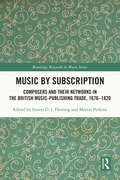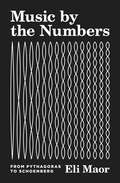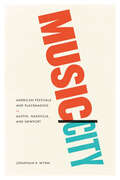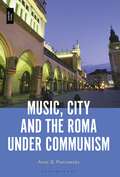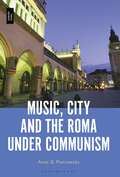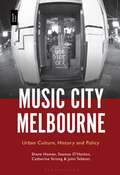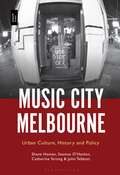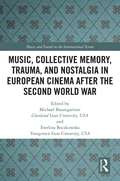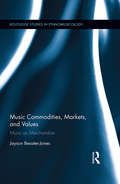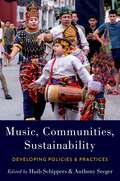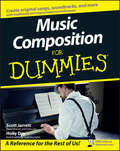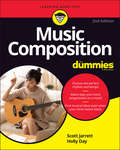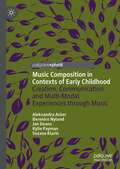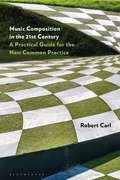- Table View
- List View
Music by Subscription: Composers and their Networks in the British Music-Publishing Trade, 1676–1820 (Routledge Research in Music)
by Simon D. I. Fleming Martin PerkinsThis book breaks new ground in the social and cultural history of eighteenth-century music in Britain through the study of a hitherto neglected resource, the lists of subscribers that were attached to a wide variety of publications, including musical works. These lists shed considerable light on the nature of those who subscribed to music, including their social status, place of employment, residence, and musical interests. Through broad analysis of subscription data, the contributors reveal insights into social and economic changes during the period, and the types of music favoured by groups like music clubs, the aristocracy, the clergy, and by men and women. With chapters on female composers and listeners, music and the slave economy, musical patronage, the print trade, and nationality, this book provides innovative perspectives that enhance our understanding of music’s social spheres, the emergence of music publishing, and the potential of digital musicology research.
Music by the Numbers: From Pythagoras to Schoenberg
by Eli MaorHow music has influenced mathematics, physics, and astronomy from ancient Greece to the twentieth centuryMusic is filled with mathematical elements, the works of Bach are often said to possess a math-like logic, and Igor Stravinsky said "musical form is close to mathematics," while Arnold Schoenberg, Iannis Xenakis, and Karlheinz Stockhausen went further, writing music explicitly based on mathematical principles. Yet Eli Maor argues that music has influenced math at least as much as math has influenced music. Starting with Pythagoras, proceeding through the work of Schoenberg, and ending with contemporary string theory, Music by the Numbers tells a fascinating story of composers, scientists, inventors, and eccentrics who played a role in the age-old relationship between music, mathematics, and the sciences, especially physics and astronomy. Music by the Numbers explores key moments in this history, particularly how problems originating in music have inspired mathematicians for centuries. Perhaps the most famous of these problems is the vibrating string, which pitted some of the greatest mathematicians of the eighteenth century against each other in a debate that lasted more than fifty years and that eventually led to the development of post-calculus mathematics. Other highlights in the book include a comparison between meter in music and metric in geometry, complete with examples of rhythmic patterns from Bach to Stravinsky, and an exploration of a suggestive twentieth-century development: the nearly simultaneous emergence of Einstein's theory of relativity and Schoenberg's twelve-tone system.Weaving these compelling historical episodes with Maor's personal reflections as a mathematician and lover of classical music, Music by the Numbers will delight anyone who loves mathematics and music.
Music by the Numbers: From Pythagoras to Schoenberg
by Eli MaorHow music has influenced mathematics, physics, and astronomy from ancient Greece to the twentieth centuryMusic is filled with mathematical elements, the works of Bach are often said to possess a math-like logic, and Igor Stravinsky said "musical form is close to mathematics," while Arnold Schoenberg, Iannis Xenakis, and Karlheinz Stockhausen went further, writing music explicitly based on mathematical principles. Yet Eli Maor argues that music has influenced math at least as much as math has influenced music. Starting with Pythagoras, proceeding through the work of Schoenberg, and ending with contemporary string theory, Music by the Numbers tells a fascinating story of composers, scientists, inventors, and eccentrics who played a role in the age-old relationship between music, mathematics, and the sciences, especially physics and astronomy. Music by the Numbers explores key moments in this history, particularly how problems originating in music have inspired mathematicians for centuries. Perhaps the most famous of these problems is the vibrating string, which pitted some of the greatest mathematicians of the eighteenth century against each other in a debate that lasted more than fifty years and that eventually led to the development of post-calculus mathematics. Other highlights in the book include a comparison between meter in music and metric in geometry, complete with examples of rhythmic patterns from Bach to Stravinsky, and an exploration of a suggestive twentieth-century development: the nearly simultaneous emergence of Einstein's theory of relativity and Schoenberg's twelve-tone system.Weaving these compelling historical episodes with Maor's personal reflections as a mathematician and lover of classical music, Music by the Numbers will delight anyone who loves mathematics and music.
Music/City: American Festivals and Placemaking in Austin, Nashville, and Newport
by Jonathan R. WynnAustin’s famed South by Southwest is far more than a festival celebrating indie music. It’s also a big networking party that sparks the imagination of hip, creative types and galvanizes countless pilgrimages to the city. Festivals like SXSW are a lot of fun, but for city halls, media corporations, cultural institutions, and community groups, they’re also a vital part of a complex growth strategy. In Music/City, Jonathan R. Wynn immerses us in the world of festivals, giving readers a unique perspective on contemporary urban and cultural life. Wynn tracks the history of festivals in Newport, Nashville, and Austin, taking readers on-site to consider different festival agendas and styles of organization. It’s all here: from the musician looking to build her career to the mayor who wants to exploit a local cultural scene, from a resident’s frustration over corporate branding of his city to the music executive hoping to sell records. Music/City offers a sharp perspective on cities and cultural institutions in action and analyzes how governments mobilize massive organizational resources to become promotional machines. Wynn’s analysis culminates with an impassioned argument for temporary events, claiming that when done right, temporary occasions like festivals can serve as responsive, flexible, and adaptable products attuned to local places and communities.
Music/City: American Festivals and Placemaking in Austin, Nashville, and Newport
by Jonathan R. WynnAustin’s famed South by Southwest is far more than a festival celebrating indie music. It’s also a big networking party that sparks the imagination of hip, creative types and galvanizes countless pilgrimages to the city. Festivals like SXSW are a lot of fun, but for city halls, media corporations, cultural institutions, and community groups, they’re also a vital part of a complex growth strategy. In Music/City, Jonathan R. Wynn immerses us in the world of festivals, giving readers a unique perspective on contemporary urban and cultural life. Wynn tracks the history of festivals in Newport, Nashville, and Austin, taking readers on-site to consider different festival agendas and styles of organization. It’s all here: from the musician looking to build her career to the mayor who wants to exploit a local cultural scene, from a resident’s frustration over corporate branding of his city to the music executive hoping to sell records. Music/City offers a sharp perspective on cities and cultural institutions in action and analyzes how governments mobilize massive organizational resources to become promotional machines. Wynn’s analysis culminates with an impassioned argument for temporary events, claiming that when done right, temporary occasions like festivals can serve as responsive, flexible, and adaptable products attuned to local places and communities.
Music/City: American Festivals and Placemaking in Austin, Nashville, and Newport
by Jonathan R. WynnAustin’s famed South by Southwest is far more than a festival celebrating indie music. It’s also a big networking party that sparks the imagination of hip, creative types and galvanizes countless pilgrimages to the city. Festivals like SXSW are a lot of fun, but for city halls, media corporations, cultural institutions, and community groups, they’re also a vital part of a complex growth strategy. In Music/City, Jonathan R. Wynn immerses us in the world of festivals, giving readers a unique perspective on contemporary urban and cultural life. Wynn tracks the history of festivals in Newport, Nashville, and Austin, taking readers on-site to consider different festival agendas and styles of organization. It’s all here: from the musician looking to build her career to the mayor who wants to exploit a local cultural scene, from a resident’s frustration over corporate branding of his city to the music executive hoping to sell records. Music/City offers a sharp perspective on cities and cultural institutions in action and analyzes how governments mobilize massive organizational resources to become promotional machines. Wynn’s analysis culminates with an impassioned argument for temporary events, claiming that when done right, temporary occasions like festivals can serve as responsive, flexible, and adaptable products attuned to local places and communities.
Music/City: American Festivals and Placemaking in Austin, Nashville, and Newport
by Jonathan R. WynnAustin’s famed South by Southwest is far more than a festival celebrating indie music. It’s also a big networking party that sparks the imagination of hip, creative types and galvanizes countless pilgrimages to the city. Festivals like SXSW are a lot of fun, but for city halls, media corporations, cultural institutions, and community groups, they’re also a vital part of a complex growth strategy. In Music/City, Jonathan R. Wynn immerses us in the world of festivals, giving readers a unique perspective on contemporary urban and cultural life. Wynn tracks the history of festivals in Newport, Nashville, and Austin, taking readers on-site to consider different festival agendas and styles of organization. It’s all here: from the musician looking to build her career to the mayor who wants to exploit a local cultural scene, from a resident’s frustration over corporate branding of his city to the music executive hoping to sell records. Music/City offers a sharp perspective on cities and cultural institutions in action and analyzes how governments mobilize massive organizational resources to become promotional machines. Wynn’s analysis culminates with an impassioned argument for temporary events, claiming that when done right, temporary occasions like festivals can serve as responsive, flexible, and adaptable products attuned to local places and communities.
Music/City: American Festivals and Placemaking in Austin, Nashville, and Newport
by Jonathan R. WynnAustin’s famed South by Southwest is far more than a festival celebrating indie music. It’s also a big networking party that sparks the imagination of hip, creative types and galvanizes countless pilgrimages to the city. Festivals like SXSW are a lot of fun, but for city halls, media corporations, cultural institutions, and community groups, they’re also a vital part of a complex growth strategy. In Music/City, Jonathan R. Wynn immerses us in the world of festivals, giving readers a unique perspective on contemporary urban and cultural life. Wynn tracks the history of festivals in Newport, Nashville, and Austin, taking readers on-site to consider different festival agendas and styles of organization. It’s all here: from the musician looking to build her career to the mayor who wants to exploit a local cultural scene, from a resident’s frustration over corporate branding of his city to the music executive hoping to sell records. Music/City offers a sharp perspective on cities and cultural institutions in action and analyzes how governments mobilize massive organizational resources to become promotional machines. Wynn’s analysis culminates with an impassioned argument for temporary events, claiming that when done right, temporary occasions like festivals can serve as responsive, flexible, and adaptable products attuned to local places and communities.
Music/City: American Festivals and Placemaking in Austin, Nashville, and Newport
by Jonathan R. WynnAustin’s famed South by Southwest is far more than a festival celebrating indie music. It’s also a big networking party that sparks the imagination of hip, creative types and galvanizes countless pilgrimages to the city. Festivals like SXSW are a lot of fun, but for city halls, media corporations, cultural institutions, and community groups, they’re also a vital part of a complex growth strategy. In Music/City, Jonathan R. Wynn immerses us in the world of festivals, giving readers a unique perspective on contemporary urban and cultural life. Wynn tracks the history of festivals in Newport, Nashville, and Austin, taking readers on-site to consider different festival agendas and styles of organization. It’s all here: from the musician looking to build her career to the mayor who wants to exploit a local cultural scene, from a resident’s frustration over corporate branding of his city to the music executive hoping to sell records. Music/City offers a sharp perspective on cities and cultural institutions in action and analyzes how governments mobilize massive organizational resources to become promotional machines. Wynn’s analysis culminates with an impassioned argument for temporary events, claiming that when done right, temporary occasions like festivals can serve as responsive, flexible, and adaptable products attuned to local places and communities.
Music, City and the Roma under Communism
by Anna G. PiotrowskaThis book highlights the role of Romani musical presence in Central and Eastern Europe, especially from Krakow in the Communist period, and argues that music can and should be treated as one of the main points of relation between Roma and non-Roma. It discusses Romani performers and the complexity of their situation as conditioned by the political situations starkly affected by the Communist regime, and then by its fall. Against this backdrop, the book engages with musician Stefan Dymiter (known as Corroro) as the leader of his own street band: unwelcome in the public space by the authorities, merely tolerated by others, but admired by many passers-by and respected by his peer Romain musicians and international music stars. It emphasizes the role of Romani musicians in Krakow in shaping the soundscape of the city while also demonstrating their collective and individual strategies to adapt to the new circumstances in terms of the preferred performative techniques, repertoire, and overall lifestyle.
Music, City and the Roma under Communism
by Anna G. PiotrowskaThis book highlights the role of Romani musical presence in Central and Eastern Europe, especially from Krakow in the Communist period, and argues that music can and should be treated as one of the main points of relation between Roma and non-Roma. It discusses Romani performers and the complexity of their situation as conditioned by the political situations starkly affected by the Communist regime, and then by its fall. Against this backdrop, the book engages with musician Stefan Dymiter (known as Corroro) as the leader of his own street band: unwelcome in the public space by the authorities, merely tolerated by others, but admired by many passers-by and respected by his peer Romain musicians and international music stars. It emphasizes the role of Romani musicians in Krakow in shaping the soundscape of the city while also demonstrating their collective and individual strategies to adapt to the new circumstances in terms of the preferred performative techniques, repertoire, and overall lifestyle.
Music City Melbourne: Urban Culture, History and Policy
by Shane Homan Seamus O’Hanlon Catherine Strong John TebbuttHow did Melbourne earn its place as one of the world's 'music cities'? Beginning with the arrival of rock 'n' roll in the 1950s, this book explores the development of different sectors of Melbourne's popular music ecosystem in parallel with broader population, urban planning and media industry changes in the city. The authors draw on interviews with Melbourne musicians, venue owners and policy-makers, documenting their ambitions and experiences across different periods, with accompanying spotlights on the gendered, multicultural and indigenous contexts of playing and recording in Melbourne. Focusing on pop and rock, this is the first book to provide an extensive historical lens of popular music within an urban cultural economy that in turn investigates the contemporary nature and challenges of urban music activities and policy.
Music City Melbourne: Urban Culture, History and Policy
by Shane Homan Seamus O’Hanlon Catherine Strong John TebbuttHow did Melbourne earn its place as one of the world's 'music cities'? Beginning with the arrival of rock 'n' roll in the 1950s, this book explores the development of different sectors of Melbourne's popular music ecosystem in parallel with broader population, urban planning and media industry changes in the city. The authors draw on interviews with Melbourne musicians, venue owners and policy-makers, documenting their ambitions and experiences across different periods, with accompanying spotlights on the gendered, multicultural and indigenous contexts of playing and recording in Melbourne. Focusing on pop and rock, this is the first book to provide an extensive historical lens of popular music within an urban cultural economy that in turn investigates the contemporary nature and challenges of urban music activities and policy.
Music, Collective Memory, Trauma, and Nostalgia in European Cinema after the Second World War (Music and Sound on the International Screen)
by Michael Baumgartner Ewelina BoczkowskaIn the wake of World War II, the arts and culture of Europe became a site where the devastating events of the 20th century were remembered and understood. Exploring one of the most integral elements of the cinematic experience—music—the essays in this volume consider the numerous ways in which post-war European cinema dealt with memory, trauma and nostalgia, showing how the music of these films shaped the representation of the past. The contributors consider films from the United Kingdom, Poland, the Soviet Union, France, Italy, Germany, Sweden, Austria, and the Netherlands, providing a diverse and well-rounded understanding of film music in the context of historical memory. Memory is often underrepresented within scholarly musical studies, with most of these applications found in the disciplines of ethnomusicology, popular music studies, music cognition, and psychology and music therapy. Likewise, trauma has mainly been studied in relation to music in only a few historical contexts, while nostalgia has attracted even less academic attention. In three parts, this volume addresses each area of study as it relates to the music of European cinema from 1945 to 1989, applying an interdisciplinary approach to investigate how films use music to negotiate the precarious relationships we maintain with the past. Music, Collective Memory, Trauma, and Nostalgia in European Cinema after the Second World War offers compelling arguments as to what makes music such a powerful medium for memory, trauma and nostalgia.
Music, Collective Memory, Trauma, and Nostalgia in European Cinema after the Second World War (Music and Sound on the International Screen)
by Michael Baumgartner Ewelina BoczkowskaIn the wake of World War II, the arts and culture of Europe became a site where the devastating events of the 20th century were remembered and understood. Exploring one of the most integral elements of the cinematic experience—music—the essays in this volume consider the numerous ways in which post-war European cinema dealt with memory, trauma and nostalgia, showing how the music of these films shaped the representation of the past. The contributors consider films from the United Kingdom, Poland, the Soviet Union, France, Italy, Germany, Sweden, Austria, and the Netherlands, providing a diverse and well-rounded understanding of film music in the context of historical memory. Memory is often underrepresented within scholarly musical studies, with most of these applications found in the disciplines of ethnomusicology, popular music studies, music cognition, and psychology and music therapy. Likewise, trauma has mainly been studied in relation to music in only a few historical contexts, while nostalgia has attracted even less academic attention. In three parts, this volume addresses each area of study as it relates to the music of European cinema from 1945 to 1989, applying an interdisciplinary approach to investigate how films use music to negotiate the precarious relationships we maintain with the past. Music, Collective Memory, Trauma, and Nostalgia in European Cinema after the Second World War offers compelling arguments as to what makes music such a powerful medium for memory, trauma and nostalgia.
Music Commodities, Markets, and Values: Music as Merchandise (Routledge Studies in Ethnomusicology)
by Jayson Beaster-JonesThis book examines music stores as sites of cultural production in contemporary India. Analyzing social practices of selling music in a variety of retail contexts, it focuses upon the economic and social values that are produced and circulated by music retailers in the marketplace. Based upon research conducted over a volatile ten-year period of the Indian music industry, Beaster-Jones discusses the cultural histories of the recording industry, the social changes that have accompanied India’s economic liberalization reforms, and the economic realities of selling music in India as digital circulation of music recordings gradually displaced physical distribution. The volume considers the mobilization of musical, economic, and social values as a component of branding discourses in neoliberal India, as a justification for new regimes of legitimate use and intellectual property, as a scene for the performance of cosmopolitanism by shopping, and as a site of anxiety about transformations in the marketplace. It relies upon ethnographic observation and interviews from a variety of sources within the Indian music industry, including perspectives of executives at music labels, family-run and corporate music stores, and hawkers in street markets selling counterfeit recordings. This ethnography of the practices, spaces, and anxieties of selling music in urban India will be an important resource for scholars in a wide range of fields, including ethnomusicology, anthropology, popular music studies, and South Asian studies.
Music Commodities, Markets, and Values: Music as Merchandise (Routledge Studies in Ethnomusicology)
by Jayson Beaster-JonesThis book examines music stores as sites of cultural production in contemporary India. Analyzing social practices of selling music in a variety of retail contexts, it focuses upon the economic and social values that are produced and circulated by music retailers in the marketplace. Based upon research conducted over a volatile ten-year period of the Indian music industry, Beaster-Jones discusses the cultural histories of the recording industry, the social changes that have accompanied India’s economic liberalization reforms, and the economic realities of selling music in India as digital circulation of music recordings gradually displaced physical distribution. The volume considers the mobilization of musical, economic, and social values as a component of branding discourses in neoliberal India, as a justification for new regimes of legitimate use and intellectual property, as a scene for the performance of cosmopolitanism by shopping, and as a site of anxiety about transformations in the marketplace. It relies upon ethnographic observation and interviews from a variety of sources within the Indian music industry, including perspectives of executives at music labels, family-run and corporate music stores, and hawkers in street markets selling counterfeit recordings. This ethnography of the practices, spaces, and anxieties of selling music in urban India will be an important resource for scholars in a wide range of fields, including ethnomusicology, anthropology, popular music studies, and South Asian studies.
Music, Communities, Sustainability: Developing Policies and Practices
by Huib Schippers and Anthony SeegerMusic, Communities, Sustainability, edited thoughtfully by Huib Schippers and Anthony Seeger, traces the genesis, implementation, and development of the influential 2003 UNESCO Convention on Safeguarding of the Intangible Cultural Heritage and its impact on music practices around the world. With insights from established and emerging scholars who have been there from the early beginnings to those who work with it in communities today, this book tells a riveting story that celebrates the rise in awareness that approaching music as Intangible Cultural Heritage has brought. At the same time, it critiques the discrepancies between ideologies and realities as they emerged across the globe in its first twenty years, and provides perspectives for sound futures for the planet. Gathering such varied perspectives, this essential volume tells a crucial history and expands our understanding of the possibilities and limitations of interventions in music sustainability on a global scale.
Music, Communities, Sustainability: Developing Policies and Practices
Music, Communities, Sustainability, edited thoughtfully by Huib Schippers and Anthony Seeger, traces the genesis, implementation, and development of the influential 2003 UNESCO Convention on Safeguarding of the Intangible Cultural Heritage and its impact on music practices around the world. With insights from established and emerging scholars who have been there from the early beginnings to those who work with it in communities today, this book tells a riveting story that celebrates the rise in awareness that approaching music as Intangible Cultural Heritage has brought. At the same time, it critiques the discrepancies between ideologies and realities as they emerged across the globe in its first twenty years, and provides perspectives for sound futures for the planet. Gathering such varied perspectives, this essential volume tells a crucial history and expands our understanding of the possibilities and limitations of interventions in music sustainability on a global scale.
Music Composition For Dummies
by Scott Jarrett Holly DayWant to turn that haunting tune in your head into an awesome sound in your ear? You can! Music Composition For Dummies demystifies the process of composing music and writing songs. It guides you through every step of writing your own music, from choosing the right rhythm and tempo to creating melodies and chord progressions and working with instruments and voices. In this fun and practical guide, you’ll learn how to match keys and chords to the mood you want to convey, work a form without limiting your creativity, and hammer out a musical idea, even when your mind is drawing a blank. You’ll find out how to create popular songs, classically structured pieces, and even film, TV, and video game soundtracks. And, you’ll learn what you need to know about music composition software, including Finale, Sebelius, Pro Tools, and more. Discover how to: Preserve and organize your musical ideas Work with established chord progressions or create your own Develop great rhythms Select the right instruments Find melodies in your head, your instrument, and the world around you Use major and minor scales Work with modes and moods Build melodic motifs and phrases Use the circle of fifths to harmonize Write for multiple voices Make a demo recording Filled with creative exercises to build your composing skills, Music Composition for Dummies is the resource you need to get that melody out of your head and into the world.
Music Composition For Dummies
by Scott Jarrett Holly DayYou can hum it, but can you write it down? When most people think of a composer, they picture a bewigged genius like Mozart or Beethoven frenetically directing mighty orchestras in the ornate palaces of Vienna. While that may have been the case once upon a time, modern composers make themselves heard far beyond the classical conservatoire and concert hall. These days, soundtracks are in high demand in industries such as TV, film, advertising, and even gaming to help create immersive and exciting experiences. Whatever your musical ambitions—composing a dark requiem in a beautiful Viennese apartment or producing the next great Star Wars-like movie theme in LA—the fully updated Music Composition For Dummies hits all the right notes to help you become confident in the theory and practice of composition. To help you translate your musical ideas from fleeting tunes in your head to playable bars and notation on paper, professional composer and instructor Scott Jarrett and music journalist Holly Day take you on a friendly step-by-step journey through the process of musical creation, including choosing the right rhythms and tempos, creating melodies and chord progressions, and working with instruments and voices. You’ll learn how to match keys and chords to mood, use form to enhance your creativity, and write in different styles from pop to classical—and you’ll even learn how to keep hammering away when inspiration eludes you. Organize and preserve your musical ideas Formalize your knowledge with professional vocabulary Get familiar with composition apps and software Make a demo and market on social media Filled with musical exercises to help you acquire the discipline you need for success, Music Composition For Dummies has everything you need to turn your inner soundtrack into a tuneful reality!
Music Composition For Dummies
by Scott Jarrett Holly DayYou can hum it, but can you write it down? When most people think of a composer, they picture a bewigged genius like Mozart or Beethoven frenetically directing mighty orchestras in the ornate palaces of Vienna. While that may have been the case once upon a time, modern composers make themselves heard far beyond the classical conservatoire and concert hall. These days, soundtracks are in high demand in industries such as TV, film, advertising, and even gaming to help create immersive and exciting experiences. Whatever your musical ambitions—composing a dark requiem in a beautiful Viennese apartment or producing the next great Star Wars-like movie theme in LA—the fully updated Music Composition For Dummies hits all the right notes to help you become confident in the theory and practice of composition. To help you translate your musical ideas from fleeting tunes in your head to playable bars and notation on paper, professional composer and instructor Scott Jarrett and music journalist Holly Day take you on a friendly step-by-step journey through the process of musical creation, including choosing the right rhythms and tempos, creating melodies and chord progressions, and working with instruments and voices. You’ll learn how to match keys and chords to mood, use form to enhance your creativity, and write in different styles from pop to classical—and you’ll even learn how to keep hammering away when inspiration eludes you. Organize and preserve your musical ideas Formalize your knowledge with professional vocabulary Get familiar with composition apps and software Make a demo and market on social media Filled with musical exercises to help you acquire the discipline you need for success, Music Composition For Dummies has everything you need to turn your inner soundtrack into a tuneful reality!
Music Composition in Contexts of Early Childhood: Creation, Communication and Multi-Modal Experiences through Music
by Jan Deans Berenice Nyland Aleksandra Acker Kylie Payman Suzana KlarinThis book explores the narratives of a group of four-year-old children in a composition project in an Australian early learning centre. The participants, centre staff and a composer, Stephen Leek, contributed a number of music sessions for the children, including five original songs. The book showcases young children’s communicative ability and sensitivity to wider issues. The staff in the centre have a strongly voiced philosophy that is enacted through arts-based pedagogy and incorporates significant themes including a respect for Aboriginal culture and custodial responsibility towards a sustainable future for the earth. Examples of adult and children’s ideas are illustrated through music making, singing, dancing, words, drawings and paintings, which provide insights into a world where children are viewed as active citizens and the arts have rights. The book describes the context of the centre, the history of projects and details one project as an example of “lifeworthy learning”.
Music Composition in the 21st Century: A Practical Guide for the New Common Practice
by Robert CarlThe state of contemporary music is dizzyingly diverse in terms of style, media, traditions, and techniques. How have trends in music developed over the past decades? Music Composition in the 21st Century is a guide for composers and students that helps them navigate the often daunting complexity and abundance of resources and influences that confront them as they work to achieve a personal expression.From pop to classical, the book speaks to the creative ways that new composers mix and synthesize music, creating a music that exists along a more continuous spectrum rather than in a series of siloed practices. It pays special attention to a series of critical issues that have surfaced in recent years, including harmony, the influence of minimalism, the impact of technology, strategies of "openness," sound art, collaboration, and improvisation. Robert Carl identifies an emerging common practice that allows creators to make more informed aesthetic and technical decisions and also fosters an inherently positive approach to new methods.
Music Composition in the 21st Century: A Practical Guide for the New Common Practice
by Robert CarlThe state of contemporary music is dizzyingly diverse in terms of style, media, traditions, and techniques. How have trends in music developed over the past decades? Music Composition in the 21st Century is a guide for composers and students that helps them navigate the often daunting complexity and abundance of resources and influences that confront them as they work to achieve a personal expression.From pop to classical, the book speaks to the creative ways that new composers mix and synthesize music, creating a music that exists along a more continuous spectrum rather than in a series of siloed practices. It pays special attention to a series of critical issues that have surfaced in recent years, including harmony, the influence of minimalism, the impact of technology, strategies of "openness," sound art, collaboration, and improvisation. Robert Carl identifies an emerging common practice that allows creators to make more informed aesthetic and technical decisions and also fosters an inherently positive approach to new methods.
